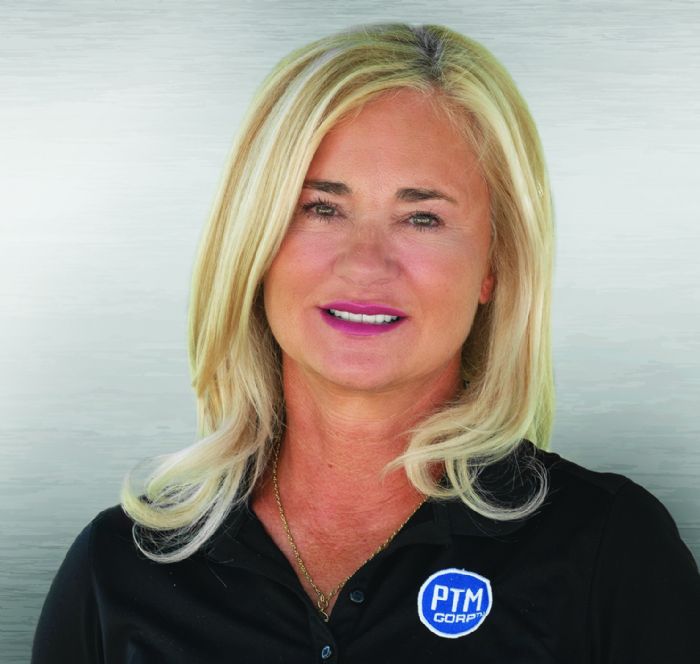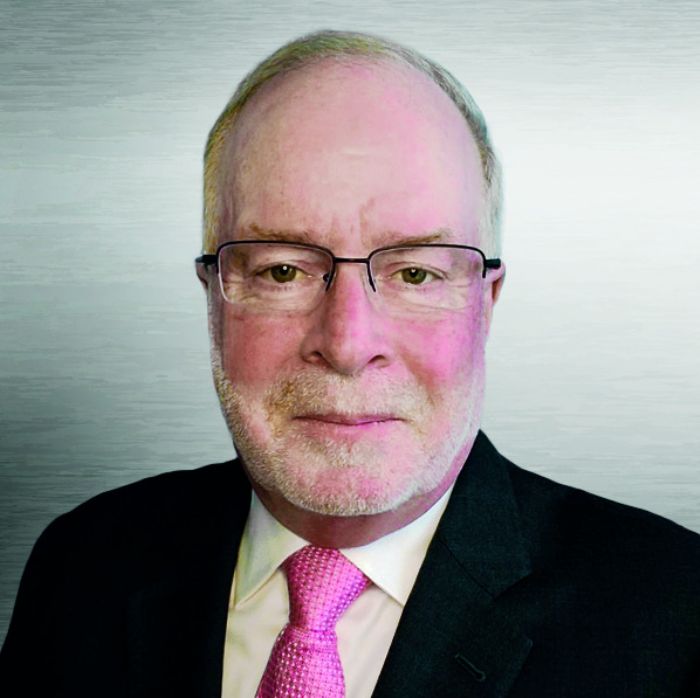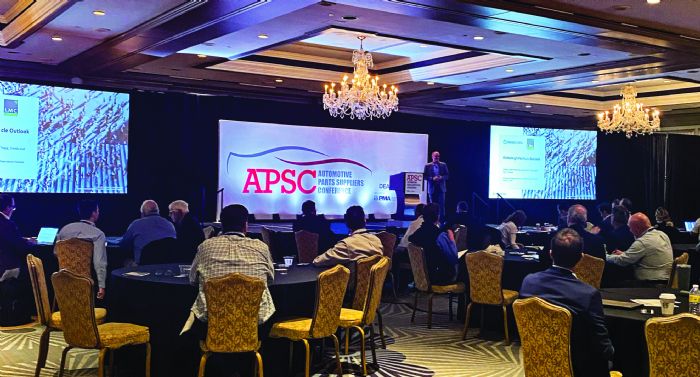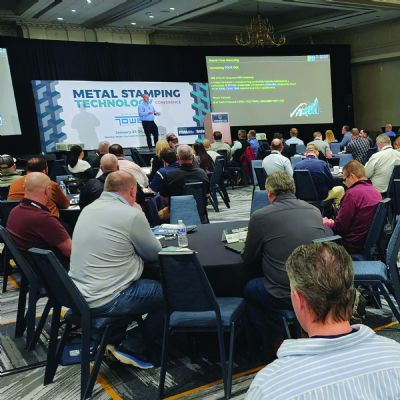Automotive Intelligence Kicks Things Off
The conference kicks off on Thursday, October 26, 11:15 a.m., with—as usual—a deep dive into industry trends, forecasts and analysis. Presenting is Jeff Schuster, group head and executive vice president, automotive, for Global Data, the parent of LMC Automotive. Schuster, who oversees the global analytics team at Global Data, and as such manages all activity for the Automotive Intelligence Center and for LMC Automotive, will provide attendees with an in-depth trend analysis and forecast. He has been tracking, forecasting and analyzing developments in the global automotive industry for more than 25 yr., and is widely quoted by the automotive media in print, internet, radio and television.
   |
| APSC again convenes the popular roundtable discussion, moderated by Steve Horaney, vice president of sales and membership at the vehicle-suppliers association MEMA. Automotive-parts supplier executives Michael Haughey (top right), president and CEO of North American Stamping Group, and Donna Kuhr (top left), CEO, president and managing partner of PTM Corp., will discuss with Horaney how suppliers can work hand-in-hand with the OEMs to best position themselves in the automotive supply chain. Kellie Lindsay (bottom), director of strategic partnerships at Autotech Ventures, leads and facilitates technical professionals and executives to create and execute product, service and business strategies. “As it relates to smaller suppliers in the supply chain, and specifically to metal forming,” Lindsay says, “there are some interesting ideas to consider in order to operate efficiently and to position your company for future competitive strength. |
Top of mind, of course, will be strategies that metal formers can use to cash in on opportunities afforded by electrification, and so it’s no surprise that PMA has this agenda item covered. Helping attendees develop a strategic plan to remain relevant as suppliers in the rapidly evolving automotive landscape: UHY LLP executives Tom Alongi, UHY partner, and principal Dan Bruce.
“The automotive value chain is experiencing a major disruptive trend,” says Bruce. “Electrification is one of the most impactful trends that we have ever seen. At first glance, metal formers may begin to worry as the production of internal combustion engine (ICE) vehicles decreases and electric vehicles (EVs) move to the forefront of the industry. In reality, while electrification will impact metal formers significantly, each individual business owner must evolve, leaning into the disruption. Otherwise, the industry will evolve without them.”
Those that lean into the disruption with a detailed and intentional strategy, offer Bruce and Alongi, can convert it into an opportunity for growth and innovation. There will be effort required and tough decisions to be made, but those who succeed have the potential to become industry leaders.
“To start, develop a dual strategy—maximize profits from current ICE volumes to fund EV growth opportunities,” Alongi explains. “Dual strategy begins with a company performing a product-portfolio assessment that evaluates the risk that electrification presents to its line of products.”
UHY’s assessment strategy involves segmenting products into three categories based on the long-term production-volume outlook for specific products: growth, stagnant or decline.
“The growth category,” explains Bruce, “includes items such as battery packs, electronics, climate control, etc., that increase with the growth of EVs. The stagnant category comprises body components, interiors, chassis, etc., and the decline category includes exhaust and fuel systems. Completing this assessment paints a clearer picture of a company’s electrification risk.”
Forecasts show that ICE vehicles are not going away any time soon, Alongi and Bruce say. Therefore, they’ll explain to APSC attendees in Greenville that the most successful metal formers will attempt to maximize profits from declining products to propel products in the stagnant and growth categories.
“Metal formers should increase operational efficiency to reduce cost and improve profits on ICE products,” says Alongi, “while deciding if they will be ICE consolidators or will exit the space. The larger number of EV-product launches expected during the next five to 10 yr. creates a market for high-mix, low-volume (HMLV) specialists. Metal formers that emerge as HMLV specialists must keep fixed costs low and look for ways to improve their HMLV capabilities.”
Always Popular: Industry Roundtable Returns
 |
|
When:
Thursday, October 26, 10 a.m.-5:30 p.m.
Friday, October 27. 8-11:30 a.m. (optional BMW Driving Experience, 12:15-4:30 p.m.)
Where:
Hyatt Regency Greenville, Greenville, SC
More information and registration details: www.pma.org/apsc
|
Continuing the discussion on the ever-evolving automotive supply chain, PMA convenes the popular roundtable discussion, expanded to 75 min. and focused on electrification and supply-chain issues. Moderated by Steve Horaney, vice president of sales and membership at the vehicle-suppliers association MEMA, the roundtable discussion will focus on two key industry best practices: collaboration and innovation. Automotive-parts supplier executives Michael Haughey, president and CEO of North American Stamping Group, and Donna Kuhr, CEO, president and managing partner of PTM Corp., will discuss with Horaney how suppliers can work hand-in-hand with the OEMs to best position themselves in the automotive supply chain.
Continuing the innovation theme, the roundtable discussion leads to a presentation on technology trends impacting the automotive metal forming market. Leading this discussion is Kellie Lindsay, director of strategic partnerships at Autotech Ventures. In her role, Lindsay leads and facilitates technical professionals and executives to create and execute product, service and business strategies. With experience across manufacturing, chemical, mechanical, electrical and software engineering, she collaborates with all facets of business teams to work on “what’s next” and get results from the automotive and ground-transportation startup ecosystem.
During her career, Lindsay served as director of marketing and strategy for vehicle-system developer Ricardo, and she was an active member of PMA while serving as director of marketing and strategy for Schuler Inc. “As it relates to smaller suppliers in the supply chain, and specifically to metal forming,” she says, “there are some interesting ideas to consider in order to operate efficiently and to position your company for future competitive strength.”
Among the topics Lindsay plans to address:
- Industry X.0 and manufacturing artificial intelligence, including software and hardware capabilities and trends
- What is coming from the OEMs and large tier suppliers in terms of sustainability—carbon footprint and carbon net-zero emissions—and tracking and tracing.
All of the above will be vigorously discussed, I’m quite sure, during the cocktail reception following Lindsay’s talk, beginning at 4:30 p.m.
A Legal Discussion with Dan Sharkey
Always a highlight for attendees of APSC is the legal discussion and Q&A session with Dan Sharkey, a partner at the law firm Brooks Wilkins Sharkey & Turco PLLC, who annually shares his perspectives with APSC attendees. Sharkey, who concentrates his practice on supply-chain issues, including negotiating contracts and litigation, has negotiated and litigated hundreds of manufacturing supply-chain disputes successfully, and he’ll again share his expertise with APSC attendees, and take questions form the audience.
Day two of APSC wraps with a discussion on the expected energy transition in the automotive landscape, from renewable energy and batteries to electrolyzers and fuel cells. Leading the discussion is Alex Chapman, president of Ridge Creek Global and lead portfolio manager for the firm’s carbon-neutral 2050 investment strategy. Chapman has seen firsthand how renewable energy, battery storage, hydrogen and fuel cells have grown from niche discussion points into a major focus among energy investors. His role has provided opportunities not only to meet with C-suite executives for multinational energy companies, but also to advise politicians on energy and economic policies.
“The discussion with automotive-parts suppliers mostly revolves around battery-electric vehicles (BEVs),” shares Chapman, “and while these talks often generate concern, more importantly, the move to BEVs also creates opportunities. For example, the battery systems for BEVs also find use for energy storage from the electrical grid. This demand for dual-use technology only will grow as demand for renewables energy increases, which creates greater intraday power-production swings. This in turn creates demand for home energy-storage systems and large grid energy-storage systems based around the same technology being used in BEVs. The opportunity is supercharged by incentives in the Inflation Reduction Act for domestic battery production.”
This opportunity will not be limited to battery development, Chapman explains; it also includes the emerging world of fuel cells, electrolyzers and hydrogen.
“Heavy-duty trucking is becoming a greater area of focus in the automotive piece of the energy transition,” he says, “in particular, hydrogen fuel-cell vehicles. And, due to needs for longer-term energy storage, electrolyzer technology is seeing a rapid growth in demand.”
Like batteries, the lines between automotive and electrical-grid suppliers are being blurred, Chapman says, and these technologies also have received substantial IRA incentives.
“I look forward to talking at APSC 2023 about the parts and assemblies involved,” he says, “and the opportunities for metal formers.”
Finally, the line between automotive and energy companies no longer is clear. “Starting with Tesla and expanding to include General Motors, Ford and others, we now see automotive OEMs not only developing BEVs but also developing home energy-storage systems and solar power,” offers Chapman. “The demand for solar power and especially solar panels assembled in the United States has increased exponentially. I’ll discuss these trends, and the opportunities for suppliers, as solar-panel manufacturing continues to be reshored and renewables become the main growth engine for U.S. energy production.” �MF
See also: Precision Metalforming Association
Technologies: Management
 APSC 2023, which runs Thursday-Friday, October 26-27, provides two days of educational sessions and networking opportunities related to the latest technology advancements impacting the automotive industry. Conference speakers also will provide an outlook for the industry and the newest factors causing disruptions.
APSC 2023, which runs Thursday-Friday, October 26-27, provides two days of educational sessions and networking opportunities related to the latest technology advancements impacting the automotive industry. Conference speakers also will provide an outlook for the industry and the newest factors causing disruptions. 











